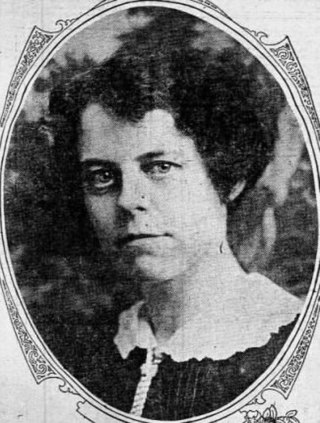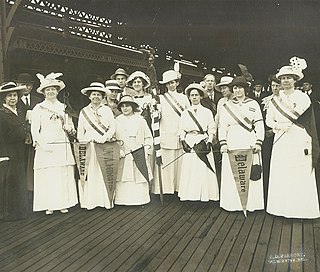
The College Equal Suffrage League (CESL) was an American woman suffrage organization founded in 1900 by Maud Wood Park and Inez Haynes Irwin, as a way to attract younger Americans to the women's rights movement. The League spurred the creation of college branches around the country and influenced the actions of other prominent groups such as National American Woman Suffrage Association (NAWSA).

Women's suffrage was established in the United States on a full or partial basis by various towns, counties, states, and territories during the latter decades of the 19th century and early part of the 20th century. As women received the right to vote in some places, they began running for public office and gaining positions as school board members, county clerks, state legislators, judges, and, in the case of Jeannette Rankin, as a member of Congress.

Maria Maud Leonard McCreery was an American suffragist, pacifist, labor activist, educator, and newspaper editor from Wisconsin.

The Men's League, made up of groups known variously as the Men's Equal Suffrage League, Men's League for Woman Suffrage, or National Men's League for Woman Suffrage, was an American men's women's suffrage organization formed by several suffragists in New York. The group was based on the idea of the British Men's League for Woman Suffrage. In the early 1900s, Oswald Garrison Villard and Anna Howard Shaw were in contact with one another regarding the creation of a group of prominent men to support women's suffrage efforts. Villard recruited Max Eastman and Stephen S. Wise to help with the project. Later, James Lees Laidlaw became the president and helped spread the concept of the group around the United States. Some colleges, like Harvard University and Swarthmore College, also had their own Men's League groups.

Women's suffrage began in Delaware the late 1860s, with efforts from suffragist, Mary Ann Sorden Stuart, and an 1869 women's rights convention held in Wilmington, Delaware. Stuart, along with prominent national suffragists lobbied the Delaware General Assembly to amend the state constitution in favor of women's suffrage. Several suffrage groups were formed early on, but the Delaware Equal Suffrage Association (DESA) formed in 1896, would become one of the major state suffrage clubs. Suffragists held conventions, continued to lobby the government and grow their movement. In 1913, a chapter of the Congressional Union (CU), which would later be known at the National Woman's Party (NWP), was set up by Mabel Vernon in Delaware. NWP advocated more militant tactics to agitate for women's suffrage. These included picketing and setting watchfires. The Silent Sentinels protested in Washington, D.C., and were arrested for "blocking traffic." Sixteen women from Delaware, including Annie Arniel and Florence Bayard Hilles, were among those who were arrested. During World War I, both African-American and white suffragists in Delaware aided the war effort. During the ratification process for the Nineteenth Amendment, Delaware was in the position to become the final state needed to complete ratification. A huge effort went into persuading the General Assembly to support the amendment. Suffragists and anti-suffragists alike campaigned in Dover, Delaware for their cause. However, Delaware did not ratify the Nineteenth Amendment until March 6, 1923, well after it was already part of the United States Constitution.

Women's suffrage began in Nevada began in the late 1860s. Lecturer and suffragist Laura de Force Gordon started giving women's suffrage speeches in the state starting in 1867. In 1869, Assemblyman Curtis J. Hillyer introduced a women's suffrage resolution in the Nevada Legislature. He also spoke out on women's rights. Hillyer's resolution passed, but like all proposed amendments to the state constitution, must pass one more time and then go out to a voter referendum. In 1870, Nevada held its first women's suffrage convention in Battle Mountain Station. In the late 1880s, women gained the right to run for school offices and the next year several women are elected to office. A few suffrage associations were formed in the mid 1890s, with a state group operating a few women's suffrage conventions. However, after 1899, most suffrage work slowed down or stopped altogether. In 1911, the Nevada Equal Franchise Society (NEFS) was formed. Attorney Felice Cohn wrote a women's suffrage resolution that was accepted and passed the Nevada Legislature. The resolution passed again in 1913 and will go out to the voters on November 3, 1914. Suffragists in the state organized heavily for the 1914 vote. Anne Henrietta Martin brought in suffragists and trade unionists from other states to help campaign. Martin and Mabel Vernon traveled around the state in a rented Ford Model T, covering thousands of miles. Suffragists in Nevada visited mining towns and even went down into mines to talk to voters. On November 3, the voters of Nevada voted overwhelmingly for women's suffrage. Even though Nevada women won the vote, they did not stop campaigning for women's suffrage. Nevada suffragists aided other states' campaigns and worked towards securing a federal suffrage amendment. On February 7, 1920, Nevada became the 28th state to ratify the Nineteenth Amendment.

This is a timeline of women's suffrage in Nevada. In 1869, Curtis J. Hillyer introduced a women's suffrage resolution in the Nevada Legislature which passed, though it would wait for another legislative session to approve a second time. The first women's suffrage convention took place in 1870 in Battle Mountain Station. Several women's suffrage resolutions are voted on, or approved, but none complete the criteria to become amendments to the Constitution of Nevada. In the 1880s, women gain the right to run for school offices and several women run and win. Some Nevada women's suffrage groups work throughout the 1890s and hold more conventions. However, most suffrage work slows down or stops around 1899. The Nevada Equal Franchise Society (NEFS) was created in 1911. That same year, Attorney Felice Cohn writes a women's suffrage resolution that is accepted and passed by the Nevada Legislature. Anne Henrietta Martin becomes president of NEFS in 1912. The next year, Cohn's resolution passes a second time and will go out as a voter referendum the next year. On November 3, 1914 Nevada voters approve women's suffrage. Women in Nevada continue to be involved in suffrage campaigning. On February 7, 1920 Nevada ratifies the Nineteenth Amendment.

This is a timeline of women's suffrage in Pennsylvania. Activists in the state began working towards women's rights in the early 1850s, when two women's rights conventions discussed women's suffrage. A statewide group, the Pennsylvania Woman Suffrage Association (PWSA), was formed in 1869. Other regional groups were formed throughout the state over the years. Suffragists in Pittsburgh created the "Pittsburgh Plan" in 1911. In 1915, a campaign to influence voters to support women's suffrage on the November 2 referendum took place. Despite these efforts, the referendum failed. On June 24, 1919, Pennsylvania became the seventh state to ratify the Nineteenth Amendment. Pennsylvania women voted for the first time on November 2, 1920.
Mae Caine was a 20th-century American suffragist and women's rights activist, civic leader, and government official in Nevada. President of the Suffrage Society in Elko County, she was also a vice president of the Nevada Equal Franchise Society, and a delegate from Nevada to the 45th convention of the National American Woman Suffrage Association in Washington, D.C.
Lillie Mary Clinedinst was an American suffragist and labor activist.









